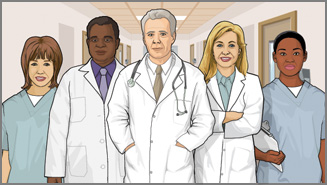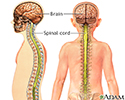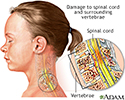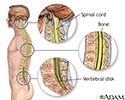Spinal injury
Spinal cord injury; SCIThe spinal cord contains the nerves that carry messages between your brain and the rest of the body. The cord passes through your neck and back. A spinal cord injury is very serious because it can cause loss of movement (paralysis), function, and sensation below the site of the injury.
-
Causes
A spinal cord injury may be caused by incidents such as:
- Bullet or stab wound
- Fracture of the spine
- Traumatic injury to the face, neck, head, chest, or back (for example, a car accident)
- Diving accident
- Electric shock
- Extreme twisting of the middle of the body
- Sports injury
- Falls
-
Symptoms
Symptoms of a spinal cord injury may include any of the following:
- Head that is in an unusual position
- Numbness or tingling that spreads down an arm or leg
- Weakness
- Difficulty walking
- Paralysis (loss of movement) of arms or legs
- Loss of bladder or bowel control
- Shock (pale, clammy skin, bluish lips and fingernails, acting dazed or semiconscious)
- Lack of alertness (unconsciousness)
- Stiff neck, headache, or neck pain
-
First Aid
Never move anyone who you think may have a spinal injury unless it is absolutely necessary. For example, if you need to get the person out of a burning car or help them to breathe.
Keep the person completely still and safe until medical help arrives.
- Call the local emergency number, such as 911.
- Hold the person's head and neck in the position in which they were found. DO NOT try to straighten the neck. DO NOT allow the neck to bend or twist.
- DO NOT allow the person to get up and walk.
If the person is not alert or responding to you:
- Check the person's breathing and circulation.
- If needed, do CPR. DO NOT do rescue breathing or change the position of the neck, do chest compressions only.
DO NOT roll the person over unless the person is vomiting or choking on blood, or you need to check for breathing.
If you need to roll the person over:
- Have someone help you.so that you can turn the person without moving the neck and head relative to the body.
- One person should be located at the person's head, the other at the person's side.
- Keep the person's head, neck, and back in line while you roll them onto one side.
-
Do Not
- DO NOT bend, twist, or lift the person's head or body.
- DO NOT attempt to move the person before medical help arrives unless it is absolutely necessary.
- DO NOT remove a football helmet or pads if a spinal injury is suspected.
-
When to Contact a Medical Professional
Call your local emergency number (such as 911) if you think someone has a spinal cord injury. DO NOT move the person unless there is urgent danger.
-
Prevention
The following may lower your risk for spinal injury:
- Wear seat belts.
- Do not drink and drive.
- Do not dive into pools, lakes, rivers, and other bodies of water, particularly if you cannot determine the depth of the water or if the water is not clear.
- Do not tackle or dive into a person with your head.
References
National Institute of Neurological Disorders and Stroke website. Spinal cord injury. www.ninds.nih.gov/health-information/disorders/spinal-cord-injury. Last reviewed October 16, 2023. Accessed October 16, 2023.
Preston-Suni K, Kaji AH. Spinal trauma. In: Walls RM, ed. Rosen's Emergency Medicine: Concepts and Clinical Practice. 10th ed. Philadelphia, PA: Elsevier; 2023:chap 35.
Willians KD. Fractures, dislocations, and fracture-dislocations of the spine. In: Azar FM, Beaty JH, eds. Campbell's Operative Orthopaedics. 14th ed. Phildelphia, PA: Elsevier; 2021:chap 41.















